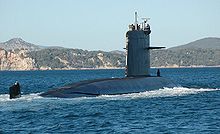
An attack submarine or hunter-killer submarine is a submarine specifically designed for the purpose of attacking and sinking other submarines, surface combatants and merchant vessels. In the Soviet and Russian navies they were and are called "multi-purpose submarines". They are also used to protect friendly surface combatants and missile submarines. Some attack subs are also armed with cruise missiles, increasing the scope of their potential missions to include land targets.

The Le Redoutable-class submarine was a ballistic missile submarine class of the French Navy. In French, the type is called Sous-marin Nucléaire Lanceur d'Engins (SNLE), literally "Missile-launching nuclear submarine". When commissioned, they constituted the strategic part of the naval component of the French nuclear triad, then called Force de frappe.
Air-independent propulsion (AIP), or air-independent power, is any marine propulsion technology that allows a non-nuclear submarine to operate without access to atmospheric oxygen. AIP can augment or replace the diesel-electric propulsion system of non-nuclear vessels.
The Barracuda class is a class of nuclear attack submarines, designed by the French shipbuilder Naval Group for the French Navy. It is intended to replace the Rubis-class submarines. Construction began in 2007 and the first unit was commissioned on 6 November 2020. The lead boat of the class, Suffren, entered service on 3 June 2022.

Le Rubis, initially named Provence, was a first-generation nuclear attack submarine and lead boat of the Rubis class of the French Navy, assigned to the attack nuclear submarine squadron.

Améthyste is a nuclear-powered attack submarine of the French Navy, the fifth of the Rubis type. The boat's name is a pun on a precious stone (Amethyst) and the acronym AMElioration Tactique, HydrodYnamique, Silence, Transmission, Ecoute. The boat is a major upgrade upon the initial design of the Rubis type, and earlier units have since been refitted to meet her standards.
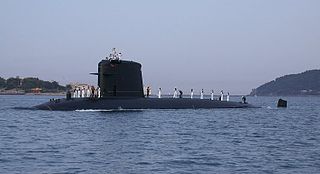
Saphir was a first-generation nuclear attack submarine of the French Navy. Saphir was the second of the Rubis series. The boat was originally to be named Bretagne, but the name was changed to Saphir before commissioning in 1981.

Casabianca was a Rubis-class nuclear attack submarine of the French Navy. Laid down in 1981, she was launched in 1984 and commissioned in 1987. She was withdrawn from service in September 2023.

Émeraude is a nuclear attack submarine from the first generation of attack submarines of the French Navy. Having been in service since 1988, she is scheduled to be retired in 2024.
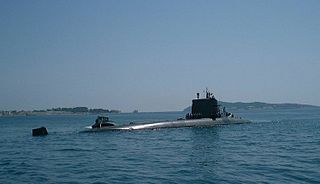
Perle is a first-generation nuclear attack submarine of the French Navy. The boat is the sixth and last of the Rubis series. Construction began on the submarine on 27 March 1987. The boat was launched on 22 September 1990 and entered active duty service on 7 July 1993.
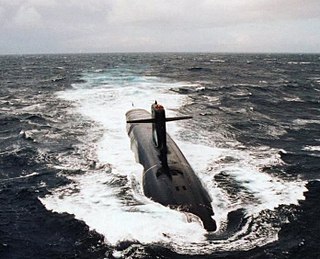
The Strategic Ocean Force has been the synonym of the French Submarine Forces since 1999, which the commandant commands the ensemble related to, along with the squadron of nuclear attack submarine.

Le Triomphant is a strategic nuclear submarine of the French Navy; the submarine is the lead boat of her class commissioned in 1997 with the home port of Île Longue. The vessel carries sixteen strategic missiles, whose launch can only be authorized by the President of France.

The Submarine Forces of France are one of the four main components of the French Navy. The force oversees all French submarines regardless of role.
The Canada-class submarine was a proposed class of ten nuclear-powered attack submarines to be built for Canadian Forces Maritime Command with an option for two more. Announced in 1987, the class was intended to provide Maritime Command with a method for monitoring Canada's Arctic Ocean area while establishing Canadian sovereignty in the area. The announcement suffered significant public and private criticism and the project was cancelled before any of the submarines could be built.

The Saphir-class submarines were a class of six submarines built in France between 1926 and 1935 for the French Navy. Most saw action during World War II for the Vichy French Navy or the Free French Naval Forces. Three were captured by Italian forces but not used.

The French submarine Diamant was a Saphir-class submarine built for the French Navy in the mid-1930s. Laid down in July 1930, it was launched in May 1933 and commissioned in June 1934. Diamant was scuttled at Toulon on 27 November 1942 to prevent her capture by German forces, then refloated by Italian forces on 29 March 1943. On 22 June 1944, Diamant was bombed and sunk at Toulon by Allied aircraft.

The French submarine Saphir was the lead ship of the Saphir-class submarines built for the French Navy in the mid-1930s. Laid down in May 1926, it was launched in December 1928 and commissioned in September 1930. Saphir was disarmed at Bizerte, Tunisia and renamed FR 112 after being captured there by Italian forces on 8 December 1942. Saphir was seized and scuttled by German forces at Naples, Italy on 15 September 1943.
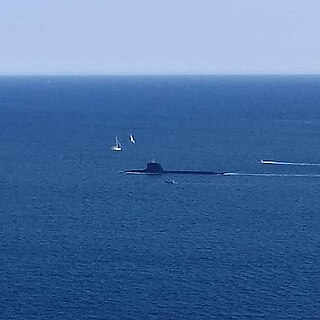
Suffren (Q284/S635) is a French nuclear attack submarine. It is the lead ship of the Suffren class, stemming from the Barracuda programme. The vessel was laid down on 19 December 2007 and launched on 1 August 2019 at Cherbourg. It was commissioned on 6 November 2020; while full operational service had originally been anticipated in 2021, this was pushed back into 2022 after further testing/trials by the French Navy. Pursuant to testing the submarine was then declared fully operational on 3 June 2022.

The SNLE 3G is a class of submarines under development for the French Navy's nuclear deterrent, part of the Force de dissuasion. It is being designed as a replacement for the current Triomphant class beginning around 2035, and could remain in service to as late as 2090.




